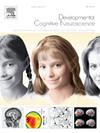Developmental trajectories of gyrification and sulcal morphometrics in children and adolescents at high familial risk for bipolar disorder or schizophrenia
IF 4.9
2区 医学
Q1 NEUROSCIENCES
引用次数: 0
Abstract
Offspring of parents with severe mental illness are at increased risk of developing psychopathology. Identifying endophenotypic markers in high-familial-risk individuals can aid in early detection and inform development of prevention strategies. Using generalized additive mixed models, we compared age trajectories of gyrification index (GI) and sulcal morphometric measures (i.e., sulcal depth, length and width) between individuals at familial risk for bipolar disorder or schizophrenia and controls. 300 T1-weighted MRI scans were obtained of 187 individuals (53 % female, age range: 8–23 years) at familial risk for bipolar disorder (n = 80, n families=55) or schizophrenia (n = 53, n families=36) and controls (n = 54, n families=33). 113 individuals underwent two scans. Globally, GI, sulcal depth and sulcal length decreased significantly with age, and sulcal width increased significantly with age in a (near-)linear manner. There were no differences between groups in age trajectories or mean values of gyrification or any of the sulcal measures. These findings suggest that, on average, young individuals at familial risk for bipolar disorder or schizophrenia have preserved developmental patterns of gyrification and sulcal morphometrics during childhood and adolescence.
双相情感障碍或精神分裂症高家族风险儿童和青少年的旋回和沟形态计量学发育轨迹
父母患有严重精神疾病的后代患精神病理的风险增加。识别高家族性风险个体的内表型标记有助于早期发现并为预防策略的制定提供信息。使用广义加性混合模型,我们比较了双相情感障碍或精神分裂症家族性风险个体和对照组之间的旋转指数(GI)和沟形态测量(即沟深度、长度和宽度)的年龄轨迹。对187名具有双相情感障碍(n = 80,n个家庭=55)或精神分裂症(n = 53,n个家庭=36)和对照组(n = 54,n个家庭=33)家族风险的个体(53 %女性,年龄范围:8-23岁)进行300次t1加权MRI扫描。113人接受了两次扫描。在全球范围内,GI、沟深和沟长随年龄的增长而显著下降,而沟宽随年龄的增长呈(近)线性增长。各组之间在年龄轨迹或旋转的平均值或任何一种测量方法上没有差异。这些发现表明,平均而言,具有双相情感障碍或精神分裂症家族风险的年轻人在儿童和青少年时期保留了旋转和沟形态测量学的发育模式。
本文章由计算机程序翻译,如有差异,请以英文原文为准。
求助全文
约1分钟内获得全文
求助全文
来源期刊

Developmental Cognitive Neuroscience
NEUROSCIENCES-
CiteScore
7.60
自引率
10.60%
发文量
124
审稿时长
6-12 weeks
期刊介绍:
The journal publishes theoretical and research papers on cognitive brain development, from infancy through childhood and adolescence and into adulthood. It covers neurocognitive development and neurocognitive processing in both typical and atypical development, including social and affective aspects. Appropriate methodologies for the journal include, but are not limited to, functional neuroimaging (fMRI and MEG), electrophysiology (EEG and ERP), NIRS and transcranial magnetic stimulation, as well as other basic neuroscience approaches using cellular and animal models that directly address cognitive brain development, patient studies, case studies, post-mortem studies and pharmacological studies.
 求助内容:
求助内容: 应助结果提醒方式:
应助结果提醒方式:


